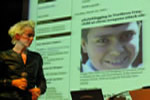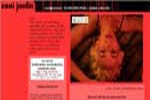 |
|
 |
|
 |
|
 |
|
 |
|
 |
|
 |
|
|
|
 |
|
 |
|
  |
| When I was a child, my father hauled an abandoned antique printing press into our house one afternoon. He was an artist and writer who had a habit of falling in love with discarded tools, the same way I became routinely obsessed with broken dogs and fallen birds. But this thing weighed over a ton. He'd become enamored with the way words from the press felt in his hands, divided into chunks of lead characters. Sentences formed like spines strung from vertebrae. I remember exactly how the blocks of type felt when he placed them in my small hands -- they were palm-sized then, but cold; sharp enough along the corners to puncture skin. Heavier than the wooden alphabet building-blocks I played with upstairs. I remember the acrid smell of black ink, and the slapping sounds of my father spreading each blob into a thin film that coated wide plates of assembled text. Gears made metallic groans when he heaved his giant body into the wheel that set the press into motion, a wheel as tall as he was, a wheel that smashed wet steel plates into paper to form printed words. The press was an elderly oddity: a fat, shut-in houseguest who consumed two rooms, accompanied by floor-to-ceiling cabinets of paper and type trays. Homes didn't have PCs in 1974, but there were many more efficient ways to speak to the world. My father wrote on a typewriter, and words were published in books, newspapers, and magazines. But words that came out of this press had a scent. A personality you could feel with your fingers. Whatever my father's words were, when they were printed this way they had history, as if he had squeezed them through a time machine on their way to the sheets of vellum extra-bright white. His press is gone now, along with the typewriter and old house they occupied. But I think about the press when I'm hunched over my laptop in an airport, clicking the "post and publish" key in Blogger to post an entry on BoingBoing. I think about that press when I'm half-awake in bed with my pocket PC and a cup of coffee, cruising websites like Daypop, Blogdex, Popdex, or Technorati to trace traffic patterns of some new digital diversion making its way through hundreds of other weblogs that morning. I think about that press when I'm wading through an online journal from some aliased stranger on the other side of the world, reading words, downloading spoken narratives in someone else's language, zooming through snapshots they've just phonecammed moments before, from Tokyo, Tahiti, Tijuana; wherever they are. I think about that press because it's pretty amazing that within one human lifetime -- okay, mine -- we can trace the evolution from lead blocks to weblogs. A simple publishing technology that allows virtually anyone, anywhere, to publish whatever they want whenever they want at virtually no cost, for immediate reach to millions of readers anywhere in the world. Just because words can be published effortlessly now doesn't mean they'll be read, or worth reading. But instant online publishing changes the way we communicate just as fundamentally as that printing press did, when it first entered the world. What are weblogs? Regularly-updated websites that typically combine some mix of first-person commentary, web links, images, and news clips, and present the blend in reverse chronological order. Some are solo journals -- personal diaries open to the world; websites that function like ultra-low-budget reality TV shows where aspiring exhibitionists can document every personal detail of daily life, from boyfriends to phone bills to what they ate for breakfast. Other blogs are like collaborative online magazines that feature multiple editorial voices. Blogs can be produced by anonymous individuals with no professional writing experience just as easily as they can by career journalists or celebrity technopundits. Blogger, one of several popular do-it-yourself publishing systems, boasts over a million registered users. The number of newly-minted weblogs continues to grow daily, powered by providers such as Movable Type, Radio Userland, and others. New services from companies like Audblog allow bloggers to speak audio entries to their sites by way of phoned-in narrative. Syndication tools like RSS allow the contents of one blog to be distributed to other blogs and websites, adding layers of diversity and inter-blog dialogue to an evolving ecosystem of ideas. The fast-spreading popularity of phonecams (mobile phones with built-in digital cameras and internet access) and other mobile imaging technologies has seeded blogging genres with newly-coined buzzwords of their own: phonecamblogs, phlogs, and fotologs, that publish images captured on the fly. As more cellphones are released with mobile video capabilities -- and more Net users gain access to faster broadband connections -- a boom in videoblogging can't be too far away. You could say that blogs evolved from the personal, tell-all homepages pioneered by web personalities like Justin Hall in the mid-1990s. The craze was popularized by companies like Geocities and Tripod later that decade. But as free and dirt-cheap blog publishing services proliferated, the number, diversity, and sophistication of weblogs grew. Many bloggers regard 2002 as the year the phenomenon hit its first major popularity peak, and blogs hit the big-time in 2003 with a number of milestones: among them, Google buys Pyra Software, the makers of Blogger; AOL introduces a blogging service to millions of subscribers; and the blogosphere's impact on conventional media is felt more strongly than ever as an Iraqi youth named Salam Pax and a CNN foreign correspondent named Kevin Sites give voice to contrasting human perspectives on the U.S. war in Iraq. And as candidates now gear up for the 2004 U.S. presidential race, weblogs have emerged as a more critical tool now than in any prior election in history. As their sphere of influence continues to grow, so do new attempts to cash in. Public relations professionals representing technology companies now regularly pitch high-profile bloggers, hoping to score favorable client mentions on well-trafficked sites. The marketing plans of American soft drink company Dr Pepper/Seven Up backfired earlier this year when an attempt to woo bloggers into talking up a new drink called "Raging Cow" were seen as exploitative -- and inspired a boycott. For most bloggers, blogging is an unpaid labor of love. Some blogs include advertising or "tip jars" (online cash donation systems), but the dilemma of how to earn a living from blogging is largely unsolved. But serial entrepreneurs such as Jason Calacanis -- whose tech business Silicon Alley Reporter magazine I worked for during the dot-com boom -- are launching new ventures that could create a sort of small-blog-business subculture. Calacanis' new company, set for launch in September, 2003, will provide bloggers whose sites cover specific business-to-business niches with tools designed to enable them to make money from their blogs. If they're successful, the line between conventional publishing and blogging will become increasingly blurred . Bloggers and journalists love to spar over the big-picture impact of blogs -- whether or not they'll eventually replace conventional journalism, how soon they'll be as common as email addresses, and whether the boom in webcam blogs self-published by topless teens is a sign of imminent cultural collapse. I don't know. But when I remember my father's printing press; when I think about the canvases he stretched to paint on with oil paint and rabbit-skin glue; when I hold pieces of paper on which he typed the words he'll be remembered by, I think this. Blogs democratize ideas. They give an almost magical
volition to words, images, and sounds. They make art available
to new audiences. Unheard voices become accessible in a
way that wasn't possible before. And that is a good thing. |